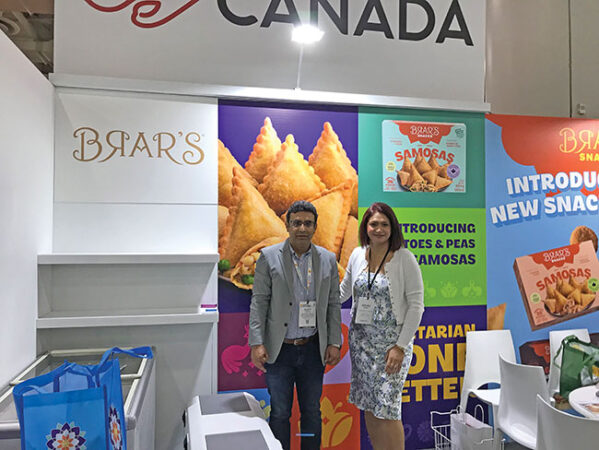
Canada-made Indian foods gain popularity in the U.S.
October 31, 2024
By Manik Mehta
The Canada pavilion at the New York Fancy Food Show had several Indian food exhibitors
 Ajay Dewan and Kiran Mann of OIC Foods at the New York Fancy Food Show. Photo © Manik Mehta
Ajay Dewan and Kiran Mann of OIC Foods at the New York Fancy Food Show. Photo © Manik Mehta The presence of, at least, three ethnic Indian food exporters from Canada at the recent New York Fancy Food Show (NYFFS) would dispel the notion that ethnic Indian food products should have the ‘made-in-India’ label. Indeed, India is no longer the only source of ethnic Indian food products that are integrating into the culinary landscape of many Western countries, particularly the United States.
Canada, which had a large pavilion with 22 companies at the NYFFS, also had three food manufacturers and suppliers of ethnic Indian food products. One such company was Ontario Impex of Canada (OIC Foods), Mississauga, Ont. Its products, sold under the Brar’s brand name, can be spotted on the shelves of various ethnic food stores and supermarkets in the United States. Punjab Milk Foods (PMF) of Surrey, B.C., showcased South Asian food products such as samosa, tawa aloo tikki, dahi ke kebab and veggie burgers. Demand Planners, also from Mississauga, Ont., exhibited paneer and vegetarian burgers, kulfi, paneer momos etc., under its Mother’s Magic brand.
Indian food goes mainstream
According to Ajay Dewan, OIC Foods’ senior sales manager, the company supplies South Asian vegetarian food products.
“As you can see from the number of visitors to our cooking demonstration here, people love our tikkis,” Dewan told Food in Canada, pointing to the line of visitors at his company’s booth wanting to sample the Indian version of spicy hash browns, which, Dewan said, was “Brar’s best-selling item” at the show.
Dewan maintained that “price is not an issue for buyers” though he acknowledged that inflation was still above average.
Kiran Mann, OIC Foods’ COO, emphasized that the show had highlighted the popularity of their products in the U.S., which has a large Indian-origin population of around 4 million. The U.S. also has a growing Pakistani, Bangladeshi, Nepalese and Sri Lankan populations, which indicates an expanding market for South Asian food and beverage products.
PMF also received a steady stream of visitors at its booth. Gurpreet Singh, PMF’s sales manager, explained that his company’s Nanak food products were fast becoming a household name in many South Asian communities in the United States. They can be found at Apna Bazar, a well-known South Asian grocery store in Jersey City, N.J., as well as in grocery outlets in Little India, a large cluster of shops in Edison, N.J., selling South Asian products.
“We are pioneers of paneer and other Indian foods. We are the largest manufacturer of paneer, dahi, ras malai etc. Ras malai is our best-selling dessert followed by gulab jamun,” Singh said.
Besides the U.S. market, Nanak products are also exported to the Middle East, New Zealand, Singapore and other Southeast Asian countries.
“However, the U.S. and Canada are our biggest markets. We also have a manufacturing facility in Pallingham, Wash., region,” Singh said.
The show had provided a good platform for his company to meet both existing and new customers.
“We hope to get more business in the future. We are participating under the Canada banner … this also enables us to get partial incentives, but no direct funding, for participating in the show,” he noted.
Though separate statistics of Canada-made Indian products sold in the U.S. market are unavailable, the products are increasingly visible on the shelves of mainstream supermarkets such as Trader Joe’s and Shoprite.
That the range of products marketed in U.S. ethnic and mainstream supermarkets continues to grow is seen as an indicator of their growing popularity among consumers.
Canada advantage
Sudhir Kumar, managing director of Demand Planner, made a strong pitch for the company’s Mother’s Magic brand of products, which included Himalayan salt, momos, and lotus seeds (a superfood in Ayurveda).
Kumar sounded upbeat about the popularity and growth potential of ethnic Indian foods in the U.S. market where, besides the large and growing South Asian and Middle Eastern diaspora, the food products are finding acceptance among mainstream American consumers.
“This is evident from the fact that Indian ethnic products are not only sold in South Asian grocery stores, but also in many mainstream American supermarkets,” he said.
As a supplier, Canada has an advantage, thanks to its proximity to the U.S. While Canadian suppliers face stiff competition from South Asian food manufacturers in the U.S., they are also conscious of the fact that quality, pricing and delivery efficacy of their supplies will be the key mantra for success in the U.S. market.
As a member of the USMCA trade pact, Canada does not face the tariff hurdles and other factors that place food manufacturers from India, the UAE, Singapore and other South Asian countries, for example, at a disadvantage. Canadian companies also do not have to worry about high freight costs. Many food producers in Canada have their own distribution network in the U.S., which is beneficial.
This article was originally published in the Aug./Sept. 2024 issue of Food in Canada.